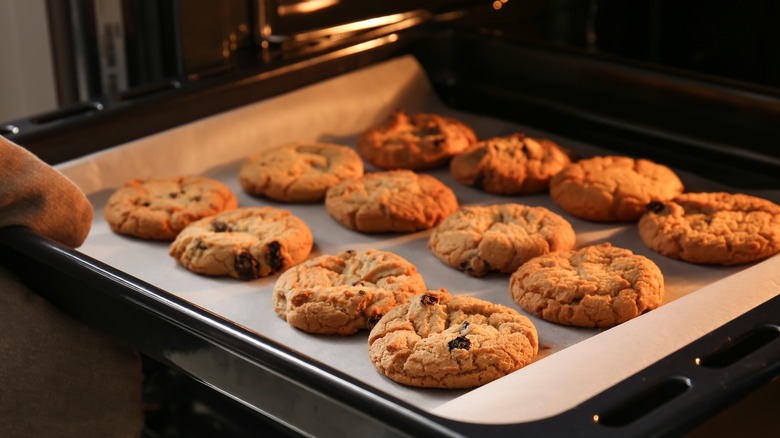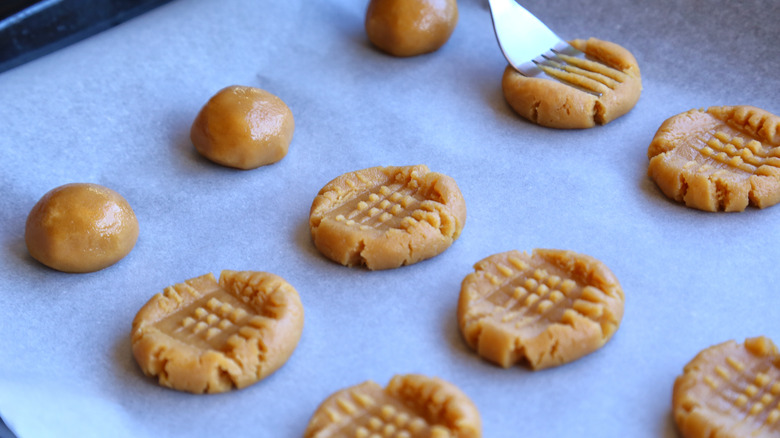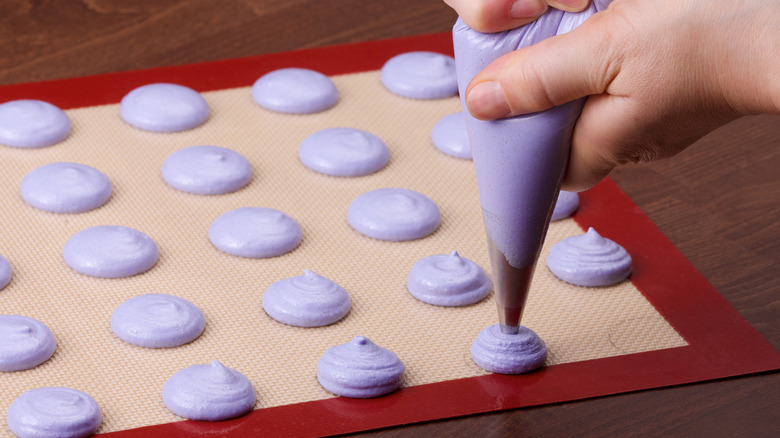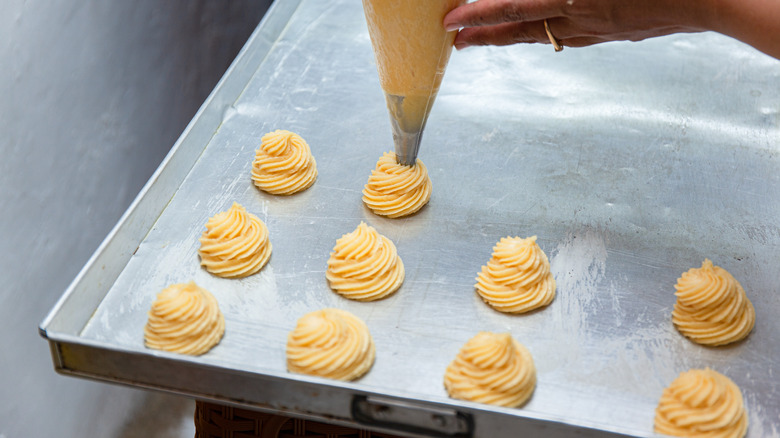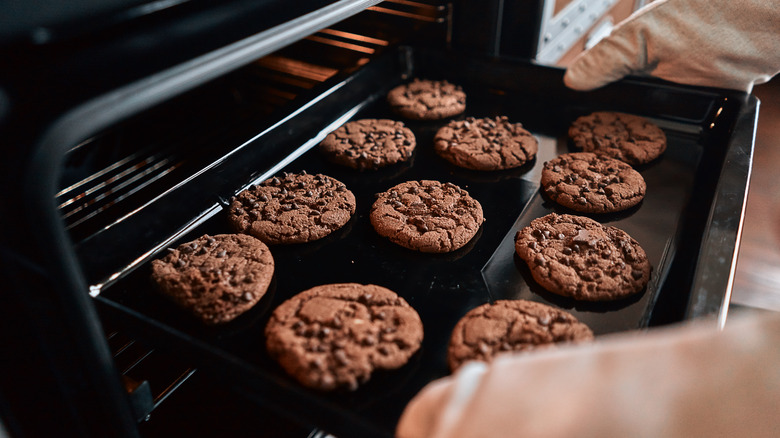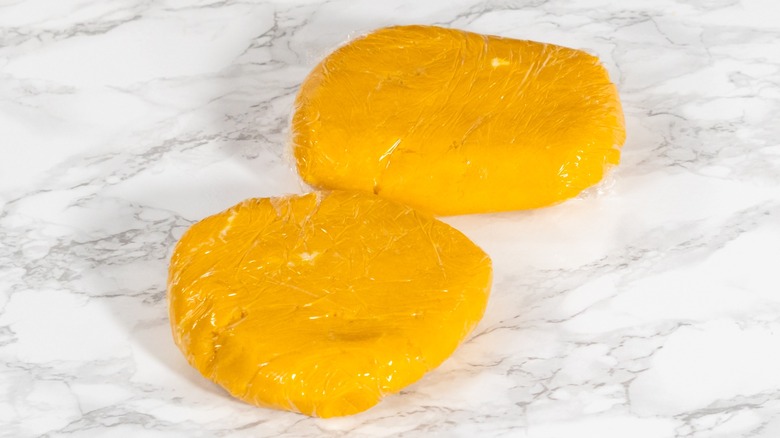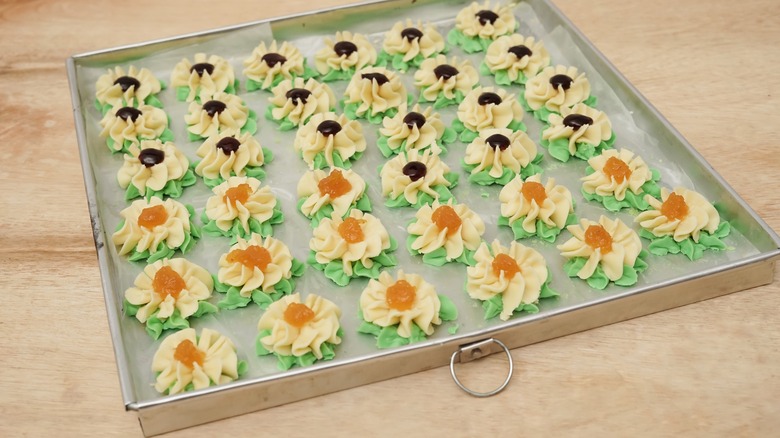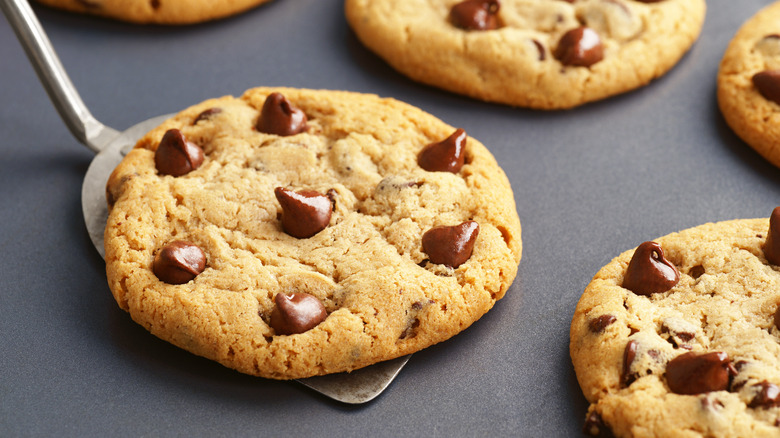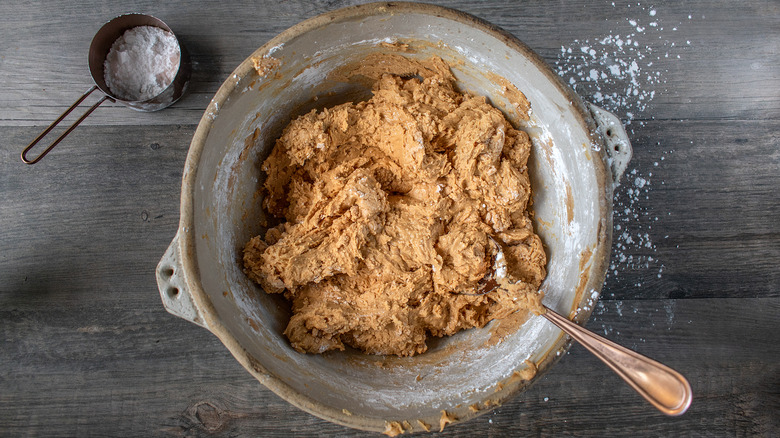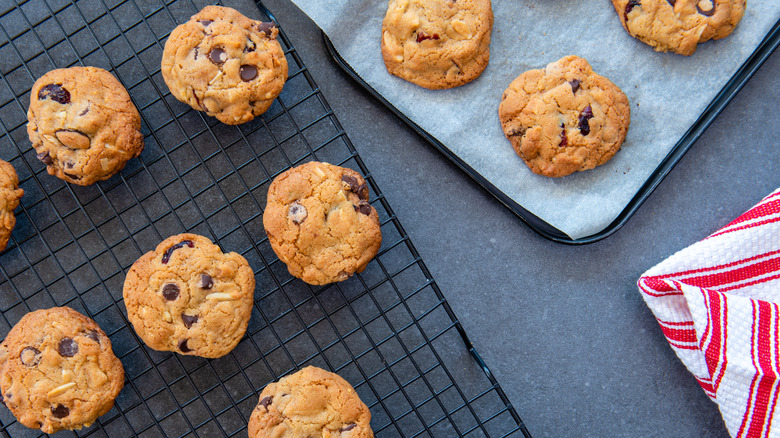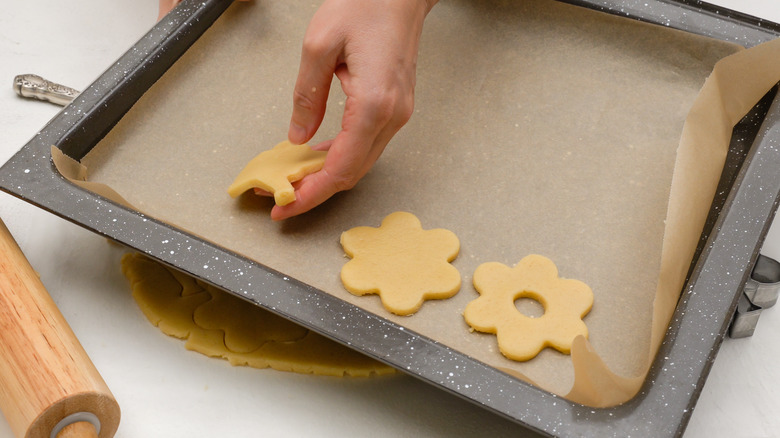The Best Ways To Keep Your Cookies From Sticking To The Pan
When it comes to baking, few things are more aggravating than having freshly baked homemade cookies stick to a cookie sheet. Whether you've invested the time and energy into whipping up a batch of chewy matcha white chocolate chip cookies or have a bunch of friends or family over awaiting your go-to sinfully sweet cinnamon snickerdoodles, having cookies crumble, stick to your baking sheet, or turn out burnt when you can't get them off the hot tray quickly enough is enough to turn anyone off of baking.
While a trusty nonstick cookie sheet may help, they aren't infallible either. Besides being expensive and sometimes hard to clean, nonstick cookie sheets are not very durable—most scratch incredibly easy, especially if you take a metal spatula or utensil anywhere near them—and many worry about the potential chemicals they can release into your food either when they get hot or if the coating should begin to flake away from the sheet after too much use.
Fortunately, you never need to buy another nonstick cookie sheet again! There are a number of great tricks and hacks out there to help keep all the cookies you bake—from your favorite most elaborate family recipes to those premade doughs you pick up at the supermarket—from sticking to your cookie sheets. Here's a look at some of our favorites.
Roll out some parchment paper
Lining pots and pans with a piece of paper to prevent sticking is a practice that dates all the way back to the Middle Ages. And while the parchment paper we have today is considerably better than the parchment of yesteryear—it includes a thin layer of silicone to make it nonstick and heat-resistant—the practice is basically otherwise unchanged.
"Parchment [paper] is a great option for almost all baking applications," says Chef Erin Kanagy-Loux, an instructor at the Auguste Escoffier School of Culinary Arts in Boulder, Colorado. "The paper provides a smooth, removable barrier between your pan and whatever you're baking. Most cookies bake well with parchment underneath."
Kierin Baldwin, chef-instructor of Pastry & Baking Arts at the Institute of Culinary Education in New York City agrees, saying that parchment paper is her de facto method to prevent cookie sticking as well.
"Even at home, I have a box of parchment paper and pretty much use that all the time. It's nice and easy," Baldwin says.
An added bonus, according to both instructors? Putting cookies on parchment paper allows you to easily move your entire batch of cookies from the fridge or freezer, to your baking sheet, and then to your cooling rack when the cookies are done. All you have to do is pick up the corners and move the cookies and parchment all at once!
Invest in a silicone baking mat
Although silicone baking mats have only been on the market for the last twenty years or so, they've completely changed the way many home bakers and professional bakers alike make cookies. These high-quality, reusable, nonstick, almost indestructible alternatives to parchment paper and traditional baking sheets are a sure way to ensure that whenever you bake, your cookies will never stick to the pan again.
"The wonderful thing about silicone baking mats is that if you take care of them, they kind of last forever," says Baldwin. "And there are some really great options out there—sheets with pre-printed marks to help you space out your cookies or measure cookie size. All kinds of great features to make baking a bit less complicated."
However, as great as silicone baking mats are, they do have a few downsides, says Kanagy-Loux.
"Silicone mats can be a bit pricey, and they may not fit all baking pans or trays," she warns. "I have also found that some brands retain some odors."
Baldwin agrees. They're great for many applications, she says, but cleaning them can be a serious challenge because they are fairly difficult to wash and clean properly. One expert hack: looks for brands that are dishwasher-safe and that are small enough to place in the top rack of your dishwasher. This will eliminate the need for hand-washing and air-drying, and get you back to cookie-making as quickly as possible!
Grease your cookie sheet
Whether you grew up with your grandma rubbing a stick of butter all over her cookie sheets, or your mom dousing her sheets with nonstick spray, greasing a cookie sheet with some sort of oil to prevent sticking is one of the oldest and most time-honored aspects of baking. And it's a practice that is still used widely to this day.
"Greasing your pan—and creating a barrier between the cookies and the baking sheet to prevent sticking—is always going to be a good option," Kanagy-Loux advises. "I prefer to spray oil due to the ease, even distribution, and its overall coating quality. However, using liquid canola or vegetable oil works just fine as well."
Her advice: always use a brush or paper towel when greasing your cookie sheet so that you evenly spread a thin layer of the oil across your sheet.
"I generally stay away from using butter because the milk solids in the butter, once melted, burn easily and quickly," she cautions. "This can cause your cookies to burn or have off flavors — in addition to a smoky oven."
Baldwin also prefers oils over butter or nonstick spray.
"[Butter or nonstick spray] will keep it from sticking, but it's gonna burn in the oven so you can get smoking from that ... The downside to having that buildup on your actual cookie sheet is that things start to stick to it even more."
Bake your cookies at a lower temperature
Most recipes suggest baking cookies at a temperature of 350 degrees Fahrenheit. However, baking cookies at a lower temperature (around 325 degrees Fahrenheit) may help to prevent sticking.
"Ultimately it's best to bake the cookie at the recommended temp," says Kanagy-Loux. But if you consistently have trouble with sticking when using the same recipe, it's worth considering dropping the oven temperature a bit, she adds.
"Depending on the formula, lowering the oven temp could help prevent sticking. The lower the temp, the longer the cookie will need to bake before it's 'done,'" she explains. "The longer the cookie bakes, the more moisture is being evaporated, which in turn is 'drying it out.' Not so much dehydrating but creating a drier, crispier product that would in theory be less likely to stick to the pan."
Whatever you do when it comes time to bake your next batch of cookies, don't try to bump up the temperature beyond what is recommended in the recipe, our experts warn. Higher temperatures can cause cookies to spread, making them more likely to stick.
Have an old oven where the temperature control might not be that accurate? Spend a few bucks on an oven thermometer so you can get an accurate reading or what temperature the oven is actually hitting. It may be running high. Once you know how off it might be, you can adjust your settings accordingly.
Always chill your dough
A handful of traditional cookie doughs (including chocolate chip cookie dough, sugar cookie dough, and shortbread cookie dough) always need to be chilled before going into the oven. The cool temperature helps to solidify the butter in these doughs so they hold their shape better as each cookie is formed. It also helps to promote a tender, crumbly texture and prevents the cookies from melting and spreading too much in the oven as they bake.
But even if you aren't making one of these specific types of cookies, chilling your dough can still pay off big-time, helping to prevent almost all types of cookies from sticking to cookie sheets as they bake.
"Chilling the dough can definitely help prevent a cookie from sticking to your pan," says Kanagy-Loux. Baldwin agrees, adding: "I think having colder dough is generally better because your cookies will spread less. Colder dough will also slow how fast your sugar [melts, preventing it from becoming] like syrup."
Although cookie specifics vary by recipe, in general consider chilling the dough between 30 minutes and one hour at a temperature between 35-40 degrees Fahrenheit. If you need to chill your dough longer than that, consider wrapping it tightly in plastic wrap or storing it in an airtight container to prevent it from drying out.
Use a light-colored cookie sheet
You may think that all cookie sheets are created equal, but that's not the case. Despite their obvious similarities, dark-colored cookie sheets actually absorb more heat when they are in the oven, causing cookies to brown quickly, increasing stickiness, and possibly even increasing risk of burning. Using a light-colored sheet doesn't pose the same sort of risks.
"I actually prefer lighter colored cookie sheets ... because lighter colored metal doesn't conduct heat quite so much," Baldwin says. "I have these beautiful heavyweight dark cookie sheets that I bought many, many years ago and I've grown to hate them because they conduct so much heat that the bottoms of my cookies always burn really easily."
So why do different color cooking sheets even exist if one is better than the other? Blame the differences on the metals used in cookie sheet production, Kanagy-Loux explains. Aluminum and steel, for example, are different colors, but they also hold and transfer heat differently as well. Lighter-colored pans reflect heat and are better for even cooking while darker pans tend to absorb the heat and are thereby better for baking very thick cookies that require extra crispiness.
One more added bonus: It's also easier to check the doneness of cookies baked on a lighter colored cookie sheet, making them ideal for amateur bakers in particular.
Opt for a metal spatula over plastic
When it comes time to remove your freshly baked cookies from the sheet, always grab a metal spatula instead of a plastic one. The reason? Even if a cookie is sticking, a metal spatula will be more likely to help you release the cookie from the sheet without breaking it.
Metal spatulas don't really help your cookie sheets to be less sticky, Baldwin points out. But they can be much more effective at separating a cookie from its cookie sheet.
"I like a very thin metal spatula that you're gonna be able to slide under the cookie without mashing it or disturbing it too much," she says. "This is especially important when the cookies are still hot and are most fragile. You want something that's very easy to get right under the cookie and lift the whole cookie up without disturbing it too much. Thick plastic and silicone spatulas aren't as good here because their edges aren't quite as sharp and they can be hard to delicately slide under a cookie."
In addition to the type of material your spatula is made from, Kanagy-Loux also recommends considering the length and width of the utensil as well.
"It helps to use a spatula that is wide enough or long enough to match the size of the cookie that is being removed," she says.
Consider a higher fat recipe
If you have some flexibility in the type of cookie you feel like baking — and want to ensure your cookies don't stick to your cookie sheet — opt for a homemade cookie recipe with a higher fat content versus one with lower fat or no fat at all.
In other words, go for higher fat chocolate chip cookies, shortbread cookies, peanut butter cookies, or oatmeal cookies, which all contain a high ratio of butter or fat to flour. In contrast, steer clear of banana oat cookies, applesauce cookies, or pumpkin spice cookies. They may be lower-calorie without oils, but they are also way more prone to sticking and more difficult to bake overall because they lack that fat.
"When you bake a very high-fat cookie, they kind of end up self-greasing the cookie sheet as they bake," jokes Baldwin. That's why they naturally stick less.
Boulder's Chef Kanagy-Loux agrees.
"A higher-fat cookie will likely stick less than a cookie with a lower fat percentage," she says. But watch out! "If the high-fat cookie also has a high sugar content this can cause more sticking rather than less," she adds. "As that sugar melts and caramelizes, it will also cling to your cookie sheet—so not all higher-fat cookies are automatically 'stick free.'"
Always let cookie sheets cool before using them again
Baking a bunch of cookies for a party or family gathering? If you want to avoid sticking, never take a cookie sheet that's fresh out of the oven and add a new batch of cookies to it. Instead, always wait for the sheet to cool and then add your next round of cookies.
"Consistency is key in every area of making pastries, including cookies," says Kanagy-Loux. "So starting with a cool pan for each round of baking will help to ensure consistent final products."
If you don't allow the pan to cool, she continues, your second batch of cookies will begin to prematurely melt on that hot pan. And if the cookies are "melty" prior to going into the oven, you've changed the consistency of the dough being baked and that round of cookies likely won't turn out as good, or could end up burning or sticking to your cookie sheet.
"Instead of baking a cool or cold-shaped dough that will begin to set as is when introduced to heat, you are now attempting to set a looser mass of dough," she explains. "The dough will continue to melt, the sugars will caramelize, and everything will set as more of a crispy spread out 'cookie' that is most likely sticky."
"When you use the sheet that's already hot, your cookies will start melting on the bottom and getting a little bit messy," Baldwin elaborates. "You lose all your consistency and control."
Never overcrowd your cookie sheet
The final secret to making sure your cookies never stick to your cookie sheet? Always be sure to leave enough space between cookies on the sheet so that your cookies don't melt together.
"Evenly spacing cookies will promote an even bake on each cookie on the pan," says Kanagy-Loux. "Giving the cookies enough space apart from one another allows even heat distribution as well as airflow throughout the pan."
If there are too many cookies placed too closely together, they'll absorb the heat from the pan too quickly and instead of beginning to set and hold shape, they'll melt and grow into each other, leaving no room for airflow, she adds. This creates cookies that have cooked unevenly, that will be more difficult to remove from the pan, and that may ultimately be more sticky and prone to burning or baking as well.
One easy rule of thumb to keep in mind when it comes to cookie spacing, according to Baldwin:
Cookies with looser batters containing a lot of eggs or sugar are more likely to spread as they bake than rolled cookies (sugar cookies, shortbread, or gingerbread for example) or cookies containing ingredients like oats or nuts or dried fruit tend to be.
Have a favorite cookie recipe that always spreads and sticks? Consider swapping the butter in the recipe for Crisco.
"It will make those cookies spread less, and will also help to prevent sticking," Baldwin says.
